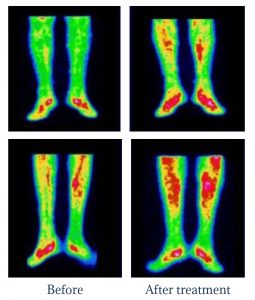Medica Institute offer minimally invasive, non-surgical, safe alternatives for Peripheral Vascular Disease treatment to get your life back on track!
 Peripheral Vascular Disease, also known as Peripheral arterial disease, and as the name implies is a condition involving the peripheral arteries. It is a condition in which blood flow to the arms, legs or other parts of the body becomes restricted. Peripheral Vascular Disease typically causes pain and fatigue, more often in legs – typically complains of pain in calf muscles, when walking that forces to stop (intermittent claudication) and especially during exercise. The arteries are narrowed or occluded by atherosclerotic plaques (deposited lipids). There is a gradual build-up of plaque in the lining of the arteries and it results in the arteries becoming narrowed, leading to a restriction in the blood flow. The rate at which the plaques develop depends on a number of factors, the risk factors for developing peripheral vascular disease would be,
Peripheral Vascular Disease, also known as Peripheral arterial disease, and as the name implies is a condition involving the peripheral arteries. It is a condition in which blood flow to the arms, legs or other parts of the body becomes restricted. Peripheral Vascular Disease typically causes pain and fatigue, more often in legs – typically complains of pain in calf muscles, when walking that forces to stop (intermittent claudication) and especially during exercise. The arteries are narrowed or occluded by atherosclerotic plaques (deposited lipids). There is a gradual build-up of plaque in the lining of the arteries and it results in the arteries becoming narrowed, leading to a restriction in the blood flow. The rate at which the plaques develop depends on a number of factors, the risk factors for developing peripheral vascular disease would be,
-
- Family history of disease
- Hypercholestrolemia or high cholesterol
- Hypertension or high blood pressure
- Diabetes
- Being overweight
- Smoking
Before Regenerative Therapy the only treatment available was surgery (angioplasty). Now a minimally invasive non-surgical Regenerative Therapy treatment offers a new horizon. By injecting your own mesenchymal cells, harvested as well as a simple blood sample, both processed and prepared in no longer than a few hours to be re-injected locally, in the affected area, new blood vessel formation (angiogenesis) is encouraged. Blood supply is restored through a bypass network of new vessels and the patient feels his extremities warm again and is able to move without pain.
Regenerative Therapy has helped untold amounts of people to improve their quality of life. It by means of several protocols will ultimately help initiate the self-healing cycle in the injured part of the body and the end result then is pain relief.
Non-surgical Regenerative treatments are a same-day procedures and the options are:
• Platelet-rich plasma – PRP therapy
• Mesenchymal cell therapy
• SVF (Stromal vascular fraction) therapy
In certain cases it may be a combination of more than one treatment protocol. For some patients however, the complete protocol is a series of injections in several treatment sessions. The choice of treatment is at the discretion of the Consultant and is based on your unique case.
Please contact us for a consultation and complete assessment to determine whether or not your condition can be treated with these minimally invasive, non-surgical regenerative procedures.
What are the top Benefits of Non-surgical Regenerative Treatments?
With so many options out there, you may be wondering what benefits choosing Non-surgical Regenerative Treatments provides. Over all Regenerative treatments are minimally invasive, non-surgical same day procedures with no risk of rejection, minimal recovery time and minimal worry. You are fully awake and ready to go home within a few hours after injections in the affected area. Since you undergo an autologous transplant with the cells that originated within your own body, your immune system has no reason to attack them and is in turn much safer than other outside sources, there is no risk of contracting a transmittable infectious disease from a donor patient also. In fact, studies thus far have indicated no safety issues with fat-derived autologous (from self) cells. Because they are your own cells, the risk of rejection is eliminated. Like any procedure, there is a minute risk of infection at the sample collection and at the injection site. To minimise that risk the procedure is carried out under strict sterile conditions.
